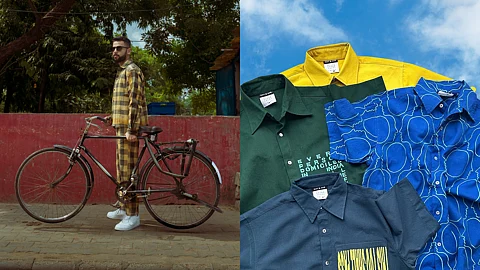
- HOMEGROWN WORLD
- #HGCREATORS
- #HGEXPLORE
- #HGVOICES
- #HGSHOP
- CAREERS
- ABOUT US
- CONTACT US

We’re all tired - of the constant rush, of looking like each other and most importantly of time fleeting by. Perhaps it is the effect of living in a world that has lived through a pandemic, we’re all counting each moment that we have. Founded by design graduates from NID, Day & Age is a fashion brand that was born from the creative collaboration between “twin spheres of graphic and textile design” in the founders' own words.
Started in February 2023 by Shreya Parasrampuria and Sharan Adka, Day & Age makes products that are crafted through slow, thoughtful processes and stitched around a central theme that is relevant to the time. The Jaipur-based label works with a small but dedicated team of artisans and tailors to create their clothing.
In their debut collection,or their first passage, they explore the notion of being ‘All Grown Up’, the concept of adulthood and growing up. In the collection note, they go on to analyse the common ways of looking at adulthood - through the lenses of science, sociology, psychology or even law - and yet they all fail to paint a complete picture of the experience. Their collection is essentially a meditation on the notion of adulthood and the expectations and realities that come with it in this partcular day and age.
Among the 18 shirts that are part of the ‘All Grown Up’ collection, Majority Act II is a striking piece - a solid cotton canvas twill shirt with a boxy cut, side pockets, mother-of-pearl buttons and bold embroidered text on the front and back. While the front pocket features the text “Every person domiciled in India shall attain the age of majority on their completing the age of eighteen years and not before”, the source of it - “Indian Majority Act of 1875” - is boldly embroidered across the back. While this might be a rather direct way of looking at the concept of becoming an adult, some of the other pieces take a more subtle approach that alludes to the confusion of being an adult, and the agony of it ( perhaps with a tongue-in-cheek embroidered shirt titled ‘silent scream’).
Label Day& Age also have a smaller collection of one-off pieces called Bygones. These are vintage and found fabrics that the founding duo has experimented with, to create one-off pieces that are imbued with character with time and age. Day & Age has explored varying fabrics including vintage Kantha quilts, dead stock Jacquard from factories and more. Since Kantha quilts are usually crafted from repurposed sarees and textiles, they feature repairs, darning, patchwork and other details that add character to the final pieces, and truly make them one-of-a-kind, upcycled pieces.
While the sourcing and state of the found fabrics are important, the label also follows an intuitive organic approach towards upcycling them. The sourced fabrics are closely examined and mapped for interesting details such as textures or colour blocking and then they are cut with the final product in mind and then stitched. The Bygones collection is also a way for the team to explore varying avenues of garment construction without being wasteful. For the founding duo of Label Day & Age, Bygones in their own words is, “ a way to relook at these age-old fabrics from today’s point of view and see how they can be reinterpreted.”
From having observed the harmful effects of the fashion industry, the founders hoped to find an effective way of intervention. Label Day & Age choose to balance environment and economics by producing less designs, fewer times a year and repurposing as much as possible. With this intention, the brand follows a made-to-order format of production, to ensure they are taking the slow route to clothing consumption and isn’t contributing to wastage. In addition, the very act of using found fabric to create all the pieces in their Bygone Collection is also a great way to use up and extend the life cycle of great fabrics that might have otherwise found their way to a landfill.
The brand takes a mixed-media approach to every aspect of its work and plays with varying materials, mediums and designs, not focusing solely on scalability. Instead of promising machine-like output, the brand also takes human error and imperfection in its stride and lets every potential customer know that the handmade nature of their pieces also implies that there may be subtle differences in each round of production, a small enough difference that is part of choosing to follow an untrodden, slower way of life.
In envisioning its future, the brand hopes to build a future that focuses on elevating consciousness about India’s textile heritage, fostering a deeper relationship between individuals and their attire and delving deeper into the thought of looking at textiles as a medium of communication and expression.
Follow them here.
